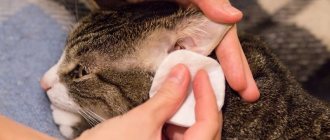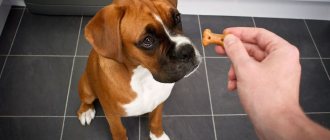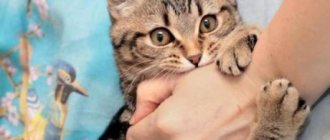The idyll between a pet and a person may one day be disrupted by one extremely delicate but global problem: the furry creature begins to completely or partially ignore the toilet. In return, the cat finds another or several other places, which first leads the owner into panic, then into rage. If the cat has stopped going to the litter box, this fact, due to the owner’s insensitivity and unwillingness to understand the problem, can one day lead to a painful separation from the animal, which equally traumatizes all participants in the situation.
As a rule, there are two reasons why a cat stopped going to the toilet: behavioral (psychological) and medical.
Therefore, do not rush to give up on your furry, because despite all the complexity, the problem can be solved if you show maximum sensitivity, observation and understanding, and, most importantly, love for your pet. After all, giving up the usual toilet is also a serious stress for him. Felines, with all their cleanliness, conservatism, attachment to territory and “rituals,” will never just abandon their favorite litter box. This happens because something is bothering them. Why did the cat stop going to the litter box? There may be several reasons, which are conditionally divided into 2 categories: behavioral (psychological) and medical.
If your cat stops going to the litter box, start monitoring her behavior.
The first ones are so diverse that sometimes it is very, very difficult to guess the source of the “shift”. The latter are more serious, because health problems always mean concern for the pet, long-term treatment (the outcome of which is unpredictable), and expenses. But the toilet problem can be solved, and this must be clearly understood. So let's deal with everything in order.
Why do cats have litter box problems?
A cat may avoid using its litter box for behavioral reasons. She might be scared. irritated or stressed about something. To start working on returning the cat to the litter box, you must first find out the reason for this behavior.
There are also medical reasons why a cat may not want or be able to use its litter box. Therefore, as soon as you notice changes in the litter box, take your cat to the vet for an examination.
What could be the reasons:
— Metabolic problems such as diabetes and kidney disease increase the amount of urine produced, and a sick cat may not be able to get to the right place in time.
— An arthritic cat may have difficulty with stairs or getting into a high litter box.
—Painful urination caused by lower urinary tract disorders may prevent your cat from successfully using the litter box.
— Constipation or diarrhea, which are of course unpleasant for a cat, can cause her to avoid the litter box.
— The cat may not like the litter.
— Dementia in older cats can cause them to forget where the litter box is or even how to use it properly. Very old cats sometimes forget skills if they develop cognitive dysfunction. The disease is similar to a form of feline Alzheimer's disease.
Naturally, if a cat is diagnosed with the above diseases, it is necessary to begin treating them so that the cat starts going to the litter box again, both big and small.
Reason #10: demonstrative behavior
Perhaps walking outside the litter box is a sign the cat is sending you. Sometimes this happens when he wants to draw attention to a problem, for example, with health or improper placement of the tray. Sometimes provocative behavior is dictated by the fact that the pet wants to receive additional attention from you.
At first he didn’t receive enough attention, but then he noticed that you scolded him for his misdeeds, that is, you paid attention to him. After that, the cat began to do this just to get another portion of attention from you. You say it's stupid because it's negative attention? No, it's not stupid. This is how not only cat psychology works, but also human psychology: negative attention is much better than complete indifference. Watch the following video about people and you will understand a lot about cats.
Article continues after advertisement
What should you do if it’s not a disease?
If your veterinarian has ruled out medical causes for the problem, your next step is to look for real psychological reasons why your cat isn't using the litter box.
For example:
— A cat whose owner’s work schedule has changed may stop using the litter box. Adjusting to a new routine may take up to two weeks or more.
-If you're away for a long period of time, you'll smell different, which can also disrupt your cat's toilet habits.
— A stressed cat may temporarily stop using its box after a big event. This could be moving to a new home, the arrival or departure of family members, the appearance or disappearance of other animals.
— A bored cat can also have problems with the litter box. Therefore, give your cat plenty of toys and daily entertainment to prevent boredom.
— Another problem may be related to the tray itself, which does not correspond to the pet’s wishes.
Reason #13: old age
In old age, not only people can suffer from incontinence, but also cats. Plus their mental abilities deteriorate. Then the cats start peeing and pooping anywhere. Don’t scold the respectable animal: it’s already difficult for him and he doesn’t do it on purpose. Instead, buy a litter box with low sides if you find that your pet has difficulty getting into the toilet. And it’s better to place several trays around the apartment so that the cat has time to reach them. Well, if your cat has incontinence, buy special cat diapers.
Wrong location
The cat wants privacy, so the litter box should be placed in an area that is least visited. Think about the location from the cat's point of view.
Do children and the dog have access to this area?
Unwanted visits and unpleasant noises may send your cat to more secluded areas. Also, the cat does not want the toilet to be near the place where it eats and sleeps.
On the other hand, cats don't want to go too far to get to the litter box.
Avoid placing the litter box in areas such as the basement.
Bad place
Sometimes cats are not satisfied with the space allocated for the toilet. It should be quiet and calm, where no one will disturb them. There is no need to place the tray next to the door or washing machine. Also, do not place it near food bowls or where the cat likes to rest.
If the cat is not satisfied with the place, you can move the tray to the place where she began to shit. It is better to wash soiled areas with preparations that do not contain ammonia, since urine also contains this component. For a cat, such a smell means that this place is intended for the toilet.
The situation can be corrected if the tray is always available. If it is in a toilet that is occupied by the owner, you can expect an unpleasant pile or puddle to appear in the wrong place.
Not enough trays
Many cat lovers have more than one cat in their home. The calculation should be as follows: one tray for each cat plus one additional one.
While young kittens will often share with each other without any problems, older cats may squabble over it. One cat in the house may actually take over the litter box and try to prevent others from using it.
Make sure multiple litter boxes are in different rooms or on different floors so they cannot be occupied by one cat.
Even if a cat is alone, she may need more than one litter box because some prefer one litter box for urine and another for feces.
Remove tag odor
How to train a toy terrier to “walk” on a diaper
Many pet owners face a serious problem - the appearance of odor from cat marks. The cause of the unpleasant odor lies in the composition of the urine:
- urochrome stains urine;
- urea makes urine sticky (when the mark area dries);
- uric acid crystallizes in cat urine and these crystals do not dissolve in water, so it is difficult to remove.
If you wash the mark area with plain water, the smell will still remain. Even if you don’t feel it, it will appear again in just a couple of days, as it has become deeply ingrained into the surface.
It is difficult to remove odor from a surface that absorbs moisture well.
Today, there are many methods for getting rid of the smell left by cats.
Folk remedies
When an adult cat or a small kitten begins to shit, it is necessary to correct the situation. With the help of folk remedies, you can quite successfully get rid of cat marks. It is not difficult to remove marks from hard surfaces. Even plain water mixed with a special product can do the job just fine. But if the cat left marks on upholstered furniture, you will have to work hard.
When removing cat tags, you must wear rubber gloves. You need to start cleaning the area right away. If you start cleaning in time, the uric acid will not have time to crystallize. When time is lost, it is almost impossible to clean without chemicals.
How to cleanse using folk remedies:
- vodka or alcohol effectively destroys organic molecules that cause odor. Alcohol is able to penetrate deeply into the tissue;
- Vinegar is an excellent mark remover. It is diluted with water in a ratio of 3:1 and the required area is wiped with a moistened sponge. The smell of vinegar dissipates over time;
- baking soda. It is mixed with vinegar. First, the mark area is generously sprinkled with soda, and then vinegar is poured. A chemical reaction occurs and the smelly, organic components disappear. This method must be used carefully, and it is not suitable for all surfaces.
Cleaning tags with folk remedies
Great for fighting cat marks:
- hydrogen peroxide;
- iodine diluted with water;
- strong brew;
- potassium permanganate.
Important! Ammonia cannot be used. The ammonia contained in ammonia can attract your pet.
Store formulations
When folk remedies do not help, special preparations are needed that can remove the odor. Pet stores offer many products that can be used to remove cat marks.
The acid contained in the urine of pets is easily evaporated under the influence of special agents.
Pet stores and hardware stores offer many products that can eliminate unpleasant odors in the home. Drugs such as Fukrtsin, Odorgon, Bio-Zh, Dufta Smoke and others neutralize uric acid contained in cat urine. The action of special preparations is aimed not only at eliminating unpleasant odors, but also at destroying harmful microbes. They are not difficult to apply. The marked area is treated with the drug and left for 30 minutes or more. Then remove the product with a damp cloth and wipe the surface dry.
Cleaning tags with special means
Not only liquid preparations, but also various sprays (Formidron, Anti-odor) can quickly cope with the task. The area where the cat has been is sprayed with a spray bottle, then, if necessary, wiped with a dry cloth. These products can be used to remove odors from tagged shoes.
To prevent unpleasant consequences associated with odor in an apartment or house, it is necessary to monitor the animal. You need to use all measures to wean your cat from walking past the litter box. Time will pass, and the pet will stop ignoring the tray.
Which litter to choose for a cat?
To ensure your cat enjoys using the tray, pay attention to the filler that your cat likes. Once you find a suitable option, you should not change it. Any change in litter may encourage your cat to avoid the litter box.
A good litter absorbs moisture, controls odors, and is liked by the cat. If you have certain preferences regarding the product, you can accustom your kitten to this option.
But adult cats have their own preferences. If, however, you have tried everything and eliminated other possible causes of litter box problems, changing the litter may be the right solution.
Does your cat prefer to go to the toilet on linoleum, wood, paper, carpet or fabric?
Try using less, less litter, or even an empty box.
You can cover it with paper, add a piece of carpet, or put in an old hand towel. The idea is to pay attention to the surface the cat likes to use and try to replicate that in the litter box to help the cat regain the habit of using the litter box.
Habit
As soon as the tailed friend passes by once, another time she will be drawn to relieve herself in the same place.
The reason for this will be the smell. Because it is the sense of smell that tells the four-legged friend where his toilet is. In undesirable places, you should take special care to get rid of the slightest smell of urine or animal excrement. The following will help eliminate the smell and scare away your pet:
- detergents;
- aerosols that repel cats, which are sold in pet stores;
- Vietnamese “Star” ointment, smeared on the floor, will certainly scare the cat away from its favorite place for the toilet;
- onion or garlic juice;
- citrus fruit peels.
© shutterstock
What to do?
Sometimes diseases whose symptom is constipation can be accompanied by other diseases. Treatment of a disease whose symptom is constipation can only be prescribed by a doctor.
Carrying out examinations on your own at home is problematic and not always effective. But you shouldn’t panic because your pet is unwell either. What should the owner do first:
- Analyze the cat’s nutrition and behavior over the last 2-3 days. Constipation may have been caused by overeating or eating unwanted foods.
- Feel the stomach. Do not press too hard. Pay attention to the animal’s reaction: does palpation cause pain.
- Give more water, stop feeding.
- If constipation occurs after surgery, go to the hospital without delay.
After analysis and determination of the severity of the symptom, it is prohibited to give any medications. Only a veterinarian can make a final diagnosis, as well as prescribe additional examinations (x-rays, ultrasound examinations, urine tests).
Helping adult cats
Adults may be prescribed enemas with the addition of oil and take laxatives. Directions, purposes, and the name of the drug are prescribed by the veterinarian. Unauthorized use is dangerous for the health and life of the cat and can provoke a worsening of the condition.
Help kittens
If a problem stool is detected in a kitten, its diet, quality of drink and food are analyzed.
If a problem stool is detected in a kitten, its diet is analyzed
The maximum assistance that the owner can provide during a pre-medical examination:
- light massage of the kitten's belly;
- starvation diet;
- drinking plenty of fluids.
If the kitten’s condition worsens or stool does not normalize, urgently seek help from a veterinary clinic.
Important! Do not attempt to treat an animal without the appropriate instructions from a doctor with dosage forms intended for an adult or child.
Enema appointment
Significant results are achieved by using an enema. The method is simple, but it is better not to use it without some practice. The first time is done by a veterinarian.
How to give an enema to a cat with constipation
For the procedure you will need a syringe without a needle and Vaseline oil, chamomile, water. Chamomile decoction can be replaced with saline solution.
Be sure to read:
How to remove the smell of cat urine: products for removing acrid odors from pets
How to perform an enema:
- Prepare chamomile decoction or saline solution at the rate of 1 tsp. chamomile or salt per 1 glass of water.
- Give cats a small amount of Vaseline oil 1-1.5 hours before the enema.
- Lubricate the tip of the syringe (the place where the needle is connected) with Vaseline and sunflower oil. Gently insert into the anus. If you have a syringe, the insertion depth should not exceed 1.5-2 cm.
- Pinch the anus with your tail. Keep the animal in your arms in this state for a quarter of an hour.
What to do at home if your cat is constipated?
Significant results are achieved by using an enema.
Douching as a method gives a positive result. But cats don’t like it, as they experience pain during the enema. Also, frequent use of a syringe as an aid has the opposite effect: the intestines stop functioning normally, and in 75% of cases the procedure provokes the appearance of ulcers.
It is strictly forbidden to use douching if:
- pregnant cat;
- the animal suffers from cardiovascular diseases;
- blood clots and bleeding were noticed;
- there are violations of the integrity of the skin in the genital area.
Important! It is dangerous to resort to self-treatment if frequent constipation occurs.











